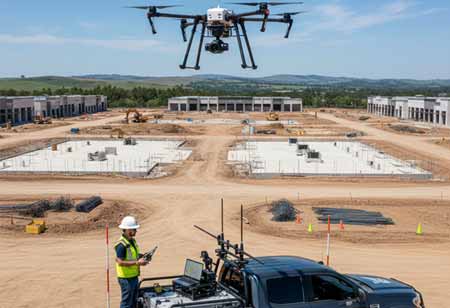THANK YOU FOR SUBSCRIBING
Be first to read the latest tech news, Industry Leader's Insights, and CIO interviews of medium and large enterprises exclusively from Applied Technology Review
AI Predictive Maintenance in Railways
In the era of technological progress, the integration of AI in railways and the introduction of innovative AI solutions have significantly transformed the transportation sector.

By
Applied Technology Review | Tuesday, October 03, 2023
Stay ahead of the industry with exclusive feature stories on the top companies, expert insights and the latest news delivered straight to your inbox. Subscribe today.
Railway networks expand with adaptable AI automation, seamlessly integrating growing infrastructures. Intelligent algorithms manage sensor data, ensuring smooth transitions.
FREMONT, CA: In the era of technological progress, the integration of AI in railways and the introduction of innovative AI solutions have significantly transformed the transportation sector. The combination of AI with predictive analytics and maintenance strategies has ushered in a new era marked by increased efficiency, safety, and reliability. AI-driven predictive analytics empowers railway operators to predict potential breakdowns, optimise maintenance schedules, and ensure uninterrupted train operations.
Advantages of Utilising Artificial Intelligence in Railway Operations
Predictive maintenance offers a multitude of advantages for the railroad sector, revolutionising maintenance methodologies. Through AI-driven predictive analytics, railways can proactively identify potential breakdowns, fine-tune maintenance schedules, and enhance overall operational effectiveness. Let's delve into the specific merits of employing predictive maintenance in this specialised industry.
Enhanced Safety and Reliability
The application of AI-powered predictive maintenance has led to transformative improvements in the railroad sector, providing unparalleled benefits in terms of safety and dependability. By integrating AI technologies into railway operations, operators can proactively address potential issues, resulting in early detection of failures. This proactive approach significantly reduces the risk of accidents and derailments, ensuring the safety of both passengers and crew members.
The impact of AI on various aspects of the railroad industry, particularly its role in predictive analytics, is profound. The integration of AI-driven predictive analytics instils confidence in the railway sector, promising a future characterised by safer, more reliable, and more efficient transportation systems.
Cost Savings and Efficiency
In the railway industry, the incorporation of AI and machine learning for predictive maintenance has led to substantial cost reductions and improved efficiency. The utilisation of AI-driven predictive analytics enables railway operators to refine their maintenance practices, yielding various advantages. The ability to anticipate potential failures in critical components such as locomotives and track infrastructure reduces downtime and disruptions, resulting in decreased operational expenses and increased reliability.
Efficient allocation of resources is ensured through optimised maintenance schedules based on real-time data, minimising unnecessary maintenance costs and resulting in significant long-term savings. Predictive maintenance also extends the lifespan of rolling stock and infrastructure, mitigating wear and tear and avoiding the need for costly replacements.
Data-Driven Decision-Making
The integration of AI into the railway sector has ushered in an era characterised by data-driven decision-making, making predictive maintenance a transformative element for the railroad industry. Through the application of AI-driven predictive analytics, railway operations gain the ability to utilise real-time data to make well-informed decisions, ultimately transforming their maintenance practices.
Sophisticated algorithms are employed to analyse extensive volumes of sensor data originating from trains, tracks, and other infrastructure elements, enabling highly accurate predictions regarding maintenance requirements. By identifying potential issues before they escalate, operators can proactively plan and schedule maintenance activities, ensuring optimal asset performance. Additionally, AI solutions tailored for railways enable the prioritisation of critical repair tasks by evaluating the severity and potential consequences of impending failures, strategically allocating resources to minimise risks and enhancing safety measures.
The adoption of data-driven decision-making techniques through predictive maintenance is fundamentally reshaping the operational landscape of railways, resulting in a more efficient and dependable transportation network that serves both passengers and freight transportation needs effectively.
Enhanced Asset Performance
The integration of machine learning into the railway sector has provided the railroad with enhanced asset performance through predictive maintenance. By utilising AI in railway operations, operators can unlock the full potential of their rolling stock and infrastructure.
With the assistance of AI-driven predictive analytics, railway systems can effectively identify bottlenecks in performance by analysing data collected from trains and tracks. This enables operators to gain valuable insights into components that hinder efficiency, allowing them to take timely actions and make targeted improvements, thereby optimising the overall railway systems.
Proactive measures are implemented to maintain peak efficiency, with intelligent algorithms continuously monitoring the condition of assets, enabling timely maintenance and calibration. This approach ensures consistent and optimal performance, resulting in reduced energy consumption and operational costs.
By optimising maintenance schedules and minimising unplanned breakdowns, predictive maintenance facilitates the maximisation of rolling stock utilisation, leading to increased revenue generation and improved resource allocation. The transformative impact of enhanced asset performance, facilitated by AI-powered predictive maintenance, establishes a new benchmark for the efficiency and reliability of railway operations.
Competitive Advantage
Predictive maintenance, driven by AI and machine learning in the railway sector, extends the advantages of AI beyond operational efficiency, giving the railroad industry a distinct competitive edge. Embracing intelligent maintenance through AI allows railway operators to distinguish themselves from conventional counterparts by implementing proactive and data-driven maintenance practices, ultimately ensuring greater service reliability and customer satisfaction.
Furthermore, this technological progress attracts tech-savvy customers and investors seeking modern, efficient, and sustainable transportation solutions. AI-powered predictive maintenance makes railways more appealing to environmentally-conscious travellers and stakeholders in search of innovative opportunities.
Leading the way in industry modernisation, forward-thinking railway organisations position themselves as pioneers in the adoption of cutting-edge technologies. This leads to enhanced operational efficiency and garners industry recognition for their commitment to transformative solutions. The adoption of predictive maintenance through AI-driven analytics ushers railways into a new era, creating a competitive advantage that guarantees success in an evolving transportation landscape.
Scalability and Future-Proofing
When AI is harnessed in the railway sector to facilitate predictive maintenance, it provides the industry with unmatched scalability and future-proofing capabilities. The adoption of AI-driven predictive analytics allows railway operators to seamlessly adapt to the evolving technological landscape.
As railway networks continue to expand, the adaptability of AI automation in the railway sector allows for the easy integration of growing infrastructures. Intelligent algorithms effectively manage data generated by an increasing number of sensors and devices, ensuring a smooth transition to larger and more intricate networks.
Through the utilisation of AI in railways, operators are taking proactive steps to safeguard their systems against the ever-changing landscape of railway transportation. Predictive maintenance, underpinned by technology, is well-equipped for the future, making it a crucial investment for sustainable and efficient railway operations.
I agree We use cookies on this website to enhance your user experience. By clicking any link on this page you are giving your consent for us to set cookies. More info








